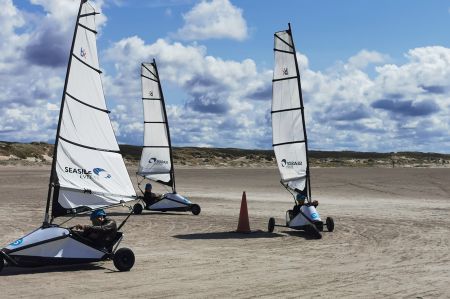Land yachting on sandy expanses of IJmuden Beach
- Written by Portal Editor
Land sailing on the sandy beaches of the coasts has a long tradition that goes back to around 1600 in Europe, especially in northern Germany and on the Dutch North Sea coast.
First, the Chinese, whose windy plains in the north offered favourable conditions for the use of wind energy, built the first land sailing ships around 500 AD, from which the actual beach sailing ships then developed. During one of our walks on the endlessly wide beach in front of the dunes, we came across numerous tourist sand yachtsmen and their guide and were immediately involved in a conversation. Here a large triangle had to be circumnavigated, which was implemented under the guidance of the guide as training for the handling of the sand yacht.
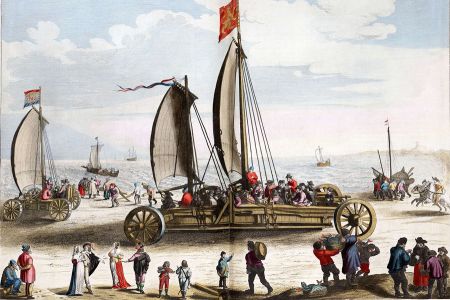 During the construction of the North Sea Canal, the IJ Bay of the Zuiderzee was used, which received an estuary (Dutch Muide) into the North Sea through the canal. The city spread out along the southern edge of the entrance to the North Sea Canal and then developed into an important fishing and supply port for the Dutch drilling platforms in the North Sea. The dominant element of the city is the large lock system with the large lighthouse and the steelworks with blast furnaces in the north. In terms of throughput, the port is the third largest in the Netherlands after Rotterdam and Amsterdam. Today it is more the huge sandy beach in front of the dunes that attracts people to the region.
During the construction of the North Sea Canal, the IJ Bay of the Zuiderzee was used, which received an estuary (Dutch Muide) into the North Sea through the canal. The city spread out along the southern edge of the entrance to the North Sea Canal and then developed into an important fishing and supply port for the Dutch drilling platforms in the North Sea. The dominant element of the city is the large lock system with the large lighthouse and the steelworks with blast furnaces in the north. In terms of throughput, the port is the third largest in the Netherlands after Rotterdam and Amsterdam. Today it is more the huge sandy beach in front of the dunes that attracts people to the region.
The Chinese are using wind energy for land transport for the first time
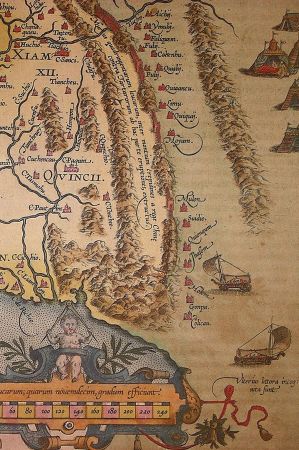 According to the first mention in the book of the "Master of the Golden Hall", which is assigned to the scholar-emperor Liang (reign 552-554 AD), the invention "sailors on land" is said to have been made by the philosopher Kao-ts'ang. According to the description, the car could carry 30 people and travel many hundreds of kilometres a day. On the famous map of China by the Flemish cartographer Abraham Ortelius from 1584, several sailing chariots are shown on the coast. The map comes from the atlas Theatrum Orbis Terrarum and is the first detailed map of China to be published in Europe.
According to the first mention in the book of the "Master of the Golden Hall", which is assigned to the scholar-emperor Liang (reign 552-554 AD), the invention "sailors on land" is said to have been made by the philosopher Kao-ts'ang. According to the description, the car could carry 30 people and travel many hundreds of kilometres a day. On the famous map of China by the Flemish cartographer Abraham Ortelius from 1584, several sailing chariots are shown on the coast. The map comes from the atlas Theatrum Orbis Terrarum and is the first detailed map of China to be published in Europe.
The reports of European travellers about the Chinese wind chariots had a stimulating effect on the imagination of Europeans and were subsequently taken up by poets. In 1589 Jan Huygen van Linschoten wrote in his book Itinerario: "The Chinese are great and imaginative craftsmen, which is what arts and crafts are all about this country shows.
They build and use carts with sails and wheels so skilfully made that they are propelled by the wind in the field - just as they are propelled on water.”
Wind-powered land vehicles are coming to Europe
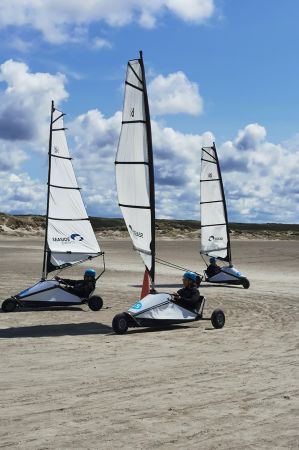 In Europe, the mathematician, physicist and hydraulic engineer Simon Stevin (1548-1620), inspired by reports about land sailors in China, built the first sailing chariot for Prince Maurice of Orange. Stevin sailed around 1600 with Prince Moritz von Oranje and 26 other people on the coast of Scheveningen and Petten. The scholar Grotius was also a participant in one of the trips. The vehicle covered a distance of approximately 95 km in less than two hours.
In Europe, the mathematician, physicist and hydraulic engineer Simon Stevin (1548-1620), inspired by reports about land sailors in China, built the first sailing chariot for Prince Maurice of Orange. Stevin sailed around 1600 with Prince Moritz von Oranje and 26 other people on the coast of Scheveningen and Petten. The scholar Grotius was also a participant in one of the trips. The vehicle covered a distance of approximately 95 km in less than two hours.
A model of the carriage was kept until 1802. The land sailors, which were mainly built in Holland at the time, reached speeds of 50 km/h.
Development of beach sailors into sports equipment
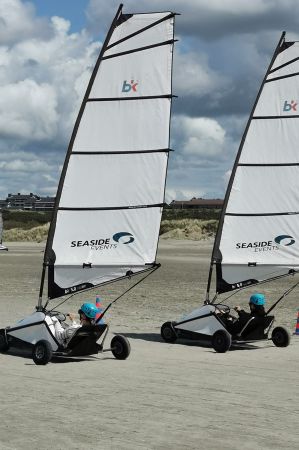 A stronghold of beach sailing in Germany is Sankt Peter-Ording, where membership in the St. Peter-Ording Yacht Club is required on the precisely defined section of beach there. In Germany, as in other countries, a sailing license is required. This is a special driving license for land and beach sailors. Furthermore, a special liability insurance is required in Germany, which expressly covers the risk of beach sailing.
A stronghold of beach sailing in Germany is Sankt Peter-Ording, where membership in the St. Peter-Ording Yacht Club is required on the precisely defined section of beach there. In Germany, as in other countries, a sailing license is required. This is a special driving license for land and beach sailors. Furthermore, a special liability insurance is required in Germany, which expressly covers the risk of beach sailing.
Beach sailing is also practiced on the East Frisian islands of Borkum, Juist, Norderney and Langeoog. Another suitable area with a designated beach for sand yachting and a local club is in the south of the island of Rømø in Denmark on Sønderstrand. Also, on the Danish North Sea island of Fanø, about 30 km further north, there is a 3 km long section on the beach at Rindby, which is designated for surfers, sand yachts and kite buggies.
If the sand yachts were originally four-wheeled commercial or cargo vehicles, today's sand yachts are used almost exclusively as sports equipment.
Form and design of the sand yachts
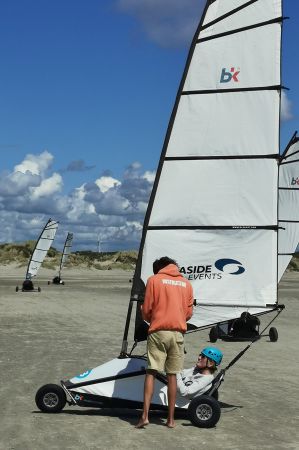 In general, a modern sand yacht resembles a kayak on three wheels with a sail. Simpler models also only consist of an uncovered tubular frame. The beach sailor is steered by a driver using a steerable front wheel. On some models, the wheels can be exchanged for runners in winter.
In general, a modern sand yacht resembles a kayak on three wheels with a sail. Simpler models also only consist of an uncovered tubular frame. The beach sailor is steered by a driver using a steerable front wheel. On some models, the wheels can be exchanged for runners in winter.
The sand yachts are divided into classes. The distinguishing features of the classes are essentially the construction, the defined dimensions and masses as well as sail areas. Today, high-performance sand yachts reach speeds of up to 130 km/h, but the amateur or recreational athlete will sail well below such speeds.
Far away from the coast, sand yachting is also practiced on larger flat meadows, fields, parking lots or other suitable areas, whereby the wind as the driving force usually blows weaker or more erratically than on the coast.
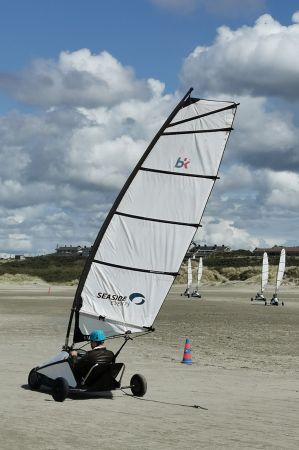 National and international sand yachting championships are even held today.
National and international sand yachting championships are even held today.
The world record was held by the Americans Bob Schumacher (pilot) and Bob Dill (designer) until 2009. In 1999, they reached a speed of 175.5 km/h with their Iron Duck in winds of between 25 and 30 knots, breaking the previous world record French Bertrand of 152.7 km / h outbid. In March 2009, Richard Jenkins from England set a new land sailing record at 202.9 km/h on the salt flats of Lake Ivanpah in Nevada. This was surpassed on December 11, 2022 by Glenn Ashby at 222.42 km/h.
Please read as well:
Zaandam – a hotel building is creating waves
Gözleme - a Turkish meal for the small hunger
-
 Sand Yachts at the beach next to Amsterdam
Sand Yachts at the beach next to Amsterdam
Sand Yachts at the beach next to Amsterdam
Sand Yachts at the beach next to Amsterdam
-
 Sand Yachts at the beach next to Amsterdam
Sand Yachts at the beach next to Amsterdam
Sand Yachts at the beach next to Amsterdam
Sand Yachts at the beach next to Amsterdam
-
 Sand Yachts at the beach next to Amsterdam
Sand Yachts at the beach next to Amsterdam
Sand Yachts at the beach next to Amsterdam
Sand Yachts at the beach next to Amsterdam
-
 Sand Yachts at the beach next to Amsterdam
Sand Yachts at the beach next to Amsterdam
Sand Yachts at the beach next to Amsterdam
Sand Yachts at the beach next to Amsterdam
-
 Sand Yachts at the beach next to Amsterdam
Sand Yachts at the beach next to Amsterdam
Sand Yachts at the beach next to Amsterdam
Sand Yachts at the beach next to Amsterdam
-
 Sand Yachts at the beach next to Amsterdam
Sand Yachts at the beach next to Amsterdam
Sand Yachts at the beach next to Amsterdam
Sand Yachts at the beach next to Amsterdam
-
 Sand Yachts at the beach next to Amsterdam
Sand Yachts at the beach next to Amsterdam
Sand Yachts at the beach next to Amsterdam
Sand Yachts at the beach next to Amsterdam
-
 Sand Yachts at the beach next to Amsterdam
Sand Yachts at the beach next to Amsterdam
Sand Yachts at the beach next to Amsterdam
Sand Yachts at the beach next to Amsterdam
-
 Sand Yachts at the beach next to Amsterdam
Sand Yachts at the beach next to Amsterdam
Sand Yachts at the beach next to Amsterdam
Sand Yachts at the beach next to Amsterdam
https://www.alaturka.info/en/netherlands/6242-land-yachting-on-sandy-expanses-of-ijmuden-beach#sigProIdd1f03f665f
